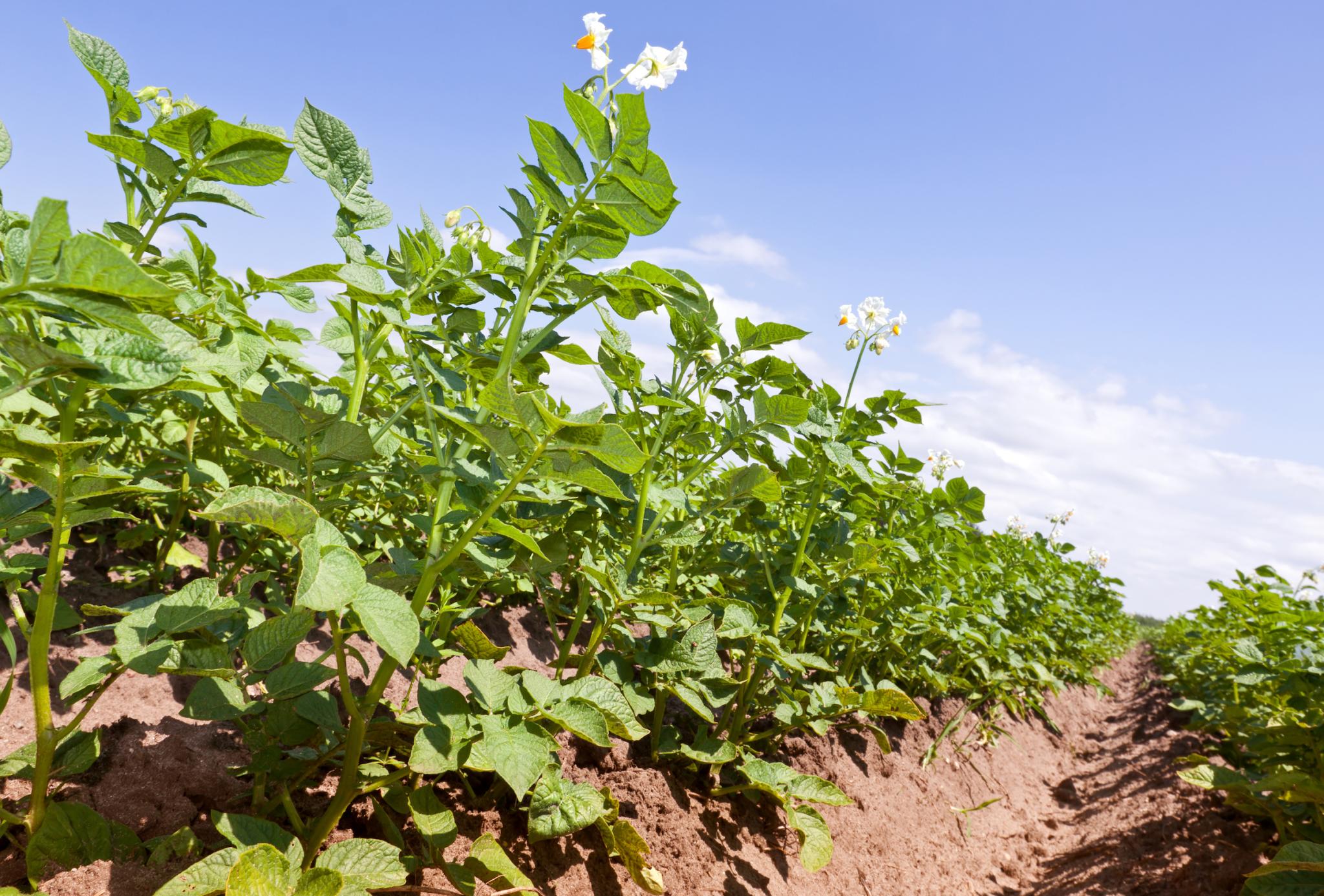
Planting, Growing, Harvesting, and Storing Potato Plants
The Almanac Garden Planner - Use It Free for 7 Days!
Plan your 2025 garden with our award-winning Garden Planner.
There are three classifications for potatoes based on when you harvest (vs. when you plant). If you harvest for storage, be sure to choose the right type:
- Early-season potatoes: first to be planted in early spring. Grow quickly (60 to 80 days), ready to harvest by early summer, tender flesh, thinner skin, store up to a few weeks.
- Mid-season potatoes (aka second early potatoes or “earlies”): mature in 80 to 100 days, typically lifted up from second half of summer, store up to a month.
- Late crops: mature in 100 to 130 days, best for storing, lasting 2 to 3 months in the right conditions; planted in August and harvested in fall.
Also, decide on the texture and flavor of your potatoes, and how you’d like to eat them:
- Dry-fleshed, mealy potatoes like russets and long white potatoes are used for baking, frying, and mashing. As mashed potatoes, they will not be gluey, and they will absorb gravy, butter or sour cream.
- Moist, waxy, round potatoes are great in soups, curries, frittatas, and salads because they don’t fall apart when cooked. You can pan-fry leftover boiled potatoes. When you mash waxy potatoes, they can become sticky.
- Red-skinned potatoes are often used for boiling or for potato salads.
Some popular potato varieties, such as ‘Yukon Gold’, fall somewhere in between truly waxy and mealy.
There are over 100 potato plant varieties! Go beyond the Idaho potato to explore more exotic and delicious options. See our article on choosing the best potato varieties!
Early Varieties:
- ‘Irish Cobbler’: tan skin, irregular shape (great heirloom potato for delicious mashed potatoes!)
- ‘Red Norland’: deep red skin, sweet, delicate flavor, great in potato salads or boiled
- ‘Mountain Rose’: red skin and pink flesh, resistant to some viruses
Mid-Season Varieties
- ‘Yukon Gold’: popular, tan skin and buttery-yellow flesh, mid to large size
- ‘Red Pontiac’: red skin, deep eyes (easiest and most adaptable red potato there is to grow)
- ‘Viking’: red skin, very productive
- ‘Chieftan’: red skin, resistant to potato scab, stores well
Late Varieties
- ‘Katahdin’: tan skin, resistant to some viruses
- ‘Kennebec’: tan skin, resistant to some viruses and late blight
- ‘Elba’: tan skin, large round tubers, resistant to blight and potato scab
- All Blue Potatoes
- ‘Fingerling Salad’ potatoes
Cooking Notes
Potatoes can be prepared in many ways: boiled, mashed, cut into pieces and roasted, french-fried, scalloped, made into dumplings or pancakes, grated into hash browns, and even brewed as alcoholic beverages.
Most potato dishes are served hot, but some are first cooked, then served cold, notably potato salad and potato chips.
ADVERTISEMENT
Our potato's are coming up, should we cover the hole plant with straw ? Or should we just let go ? They do not have flowers on them yet.
If you are growing potatoes through straw mulch, once your potato plants poke up from the first layer of straw (which is about 3 to 4 inches) and reach a height of about 4 to 6 inches, then you can cover the whole plant with another layer of straw mulch (some gardeners leave about 1 inch of the plant exposed when covering them, so that the leaves can still be exposed to light and make food for the plant). Continue doing this (covering the plant with straw once exposed plant height is 4 to 6 inches) until you have a layer of straw that is about 12 or so inches high. Then monitor the plant as it grows; do not cover the entire plant again, but do replenish the straw if it gets dislodged or flattened — you don’t want sunlight to get to the tubers, or they’ll turn green and become bitter and not safe to eat.
I have potatoes left from last year. They have sprouts approx 12 to 16" how do I plant them?
Just pulled in a couple of pounds of reds that got planted after they sprouted in the cabinet. The surprise wasn't that they grew, but that they grew in the Caribbean, with soil pH around 7.5. Even 90 degree weather didn't stop these guys
How long does it usually take for a russet potato to grow??
Days to maturity for a russet potato is 85 days.
Ive had problems with the potato bugs last year i tried something that seemed to work very well i mixed a tablespoon of liquid dish detergent with a gallon in a pump sprayer and sprayed it on my potatoes . this worked very well for me. i hope this will help someone who has a problem with potato bugs.
That stuff works great! I use it on all of my edible plants with bug issues. Great & gentle on herbs for white flys!
I have three potatoes that my family neglected to cook, and accidentally left them to grow in a cabinet. I decided to leave them there, on some paper towels on a plate. I water the towel once a day, and it's interesting how there are roots spreading across it. There is no place for me to plant them in our apartment complex, though I think I can get a pot for them
Your website states the Hardiness Zone is: 1, 2, 3, 4, 5, 6, 7, 1. I am in Hardiness Zone 8b. I know the posted Hardiness Zones are areas where the potatoes can grow best. Can I grow potatoes here? When should I plant/harvest them?














